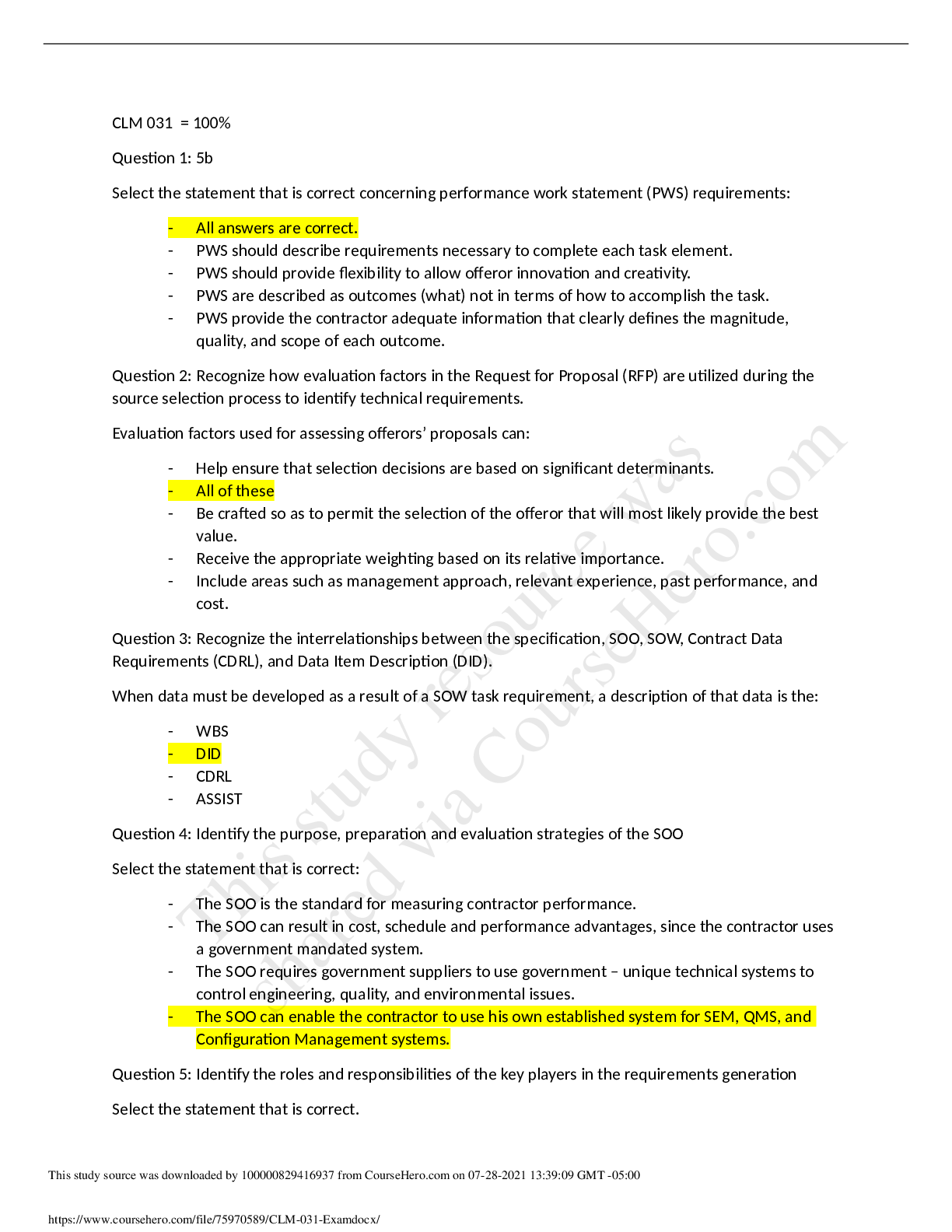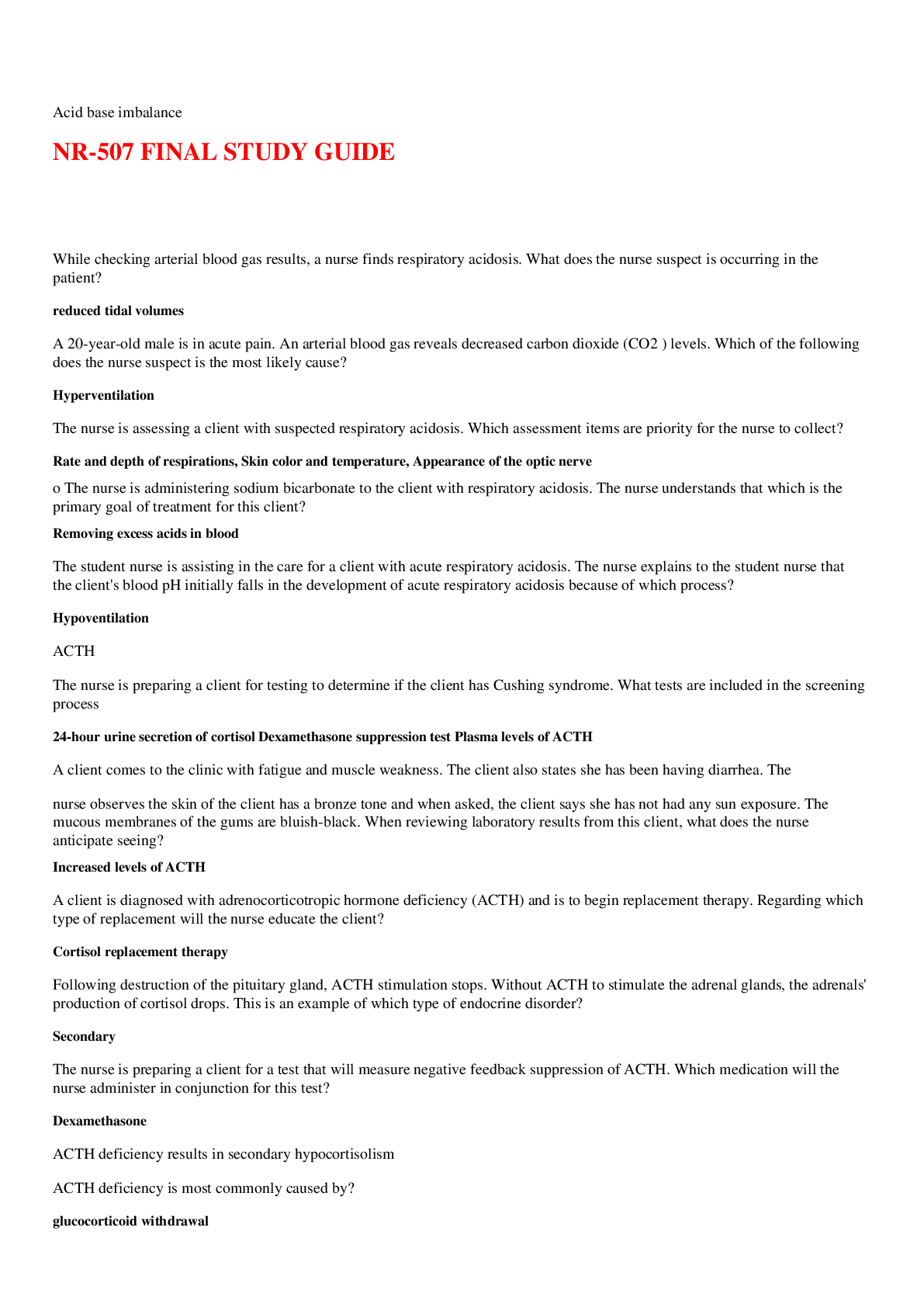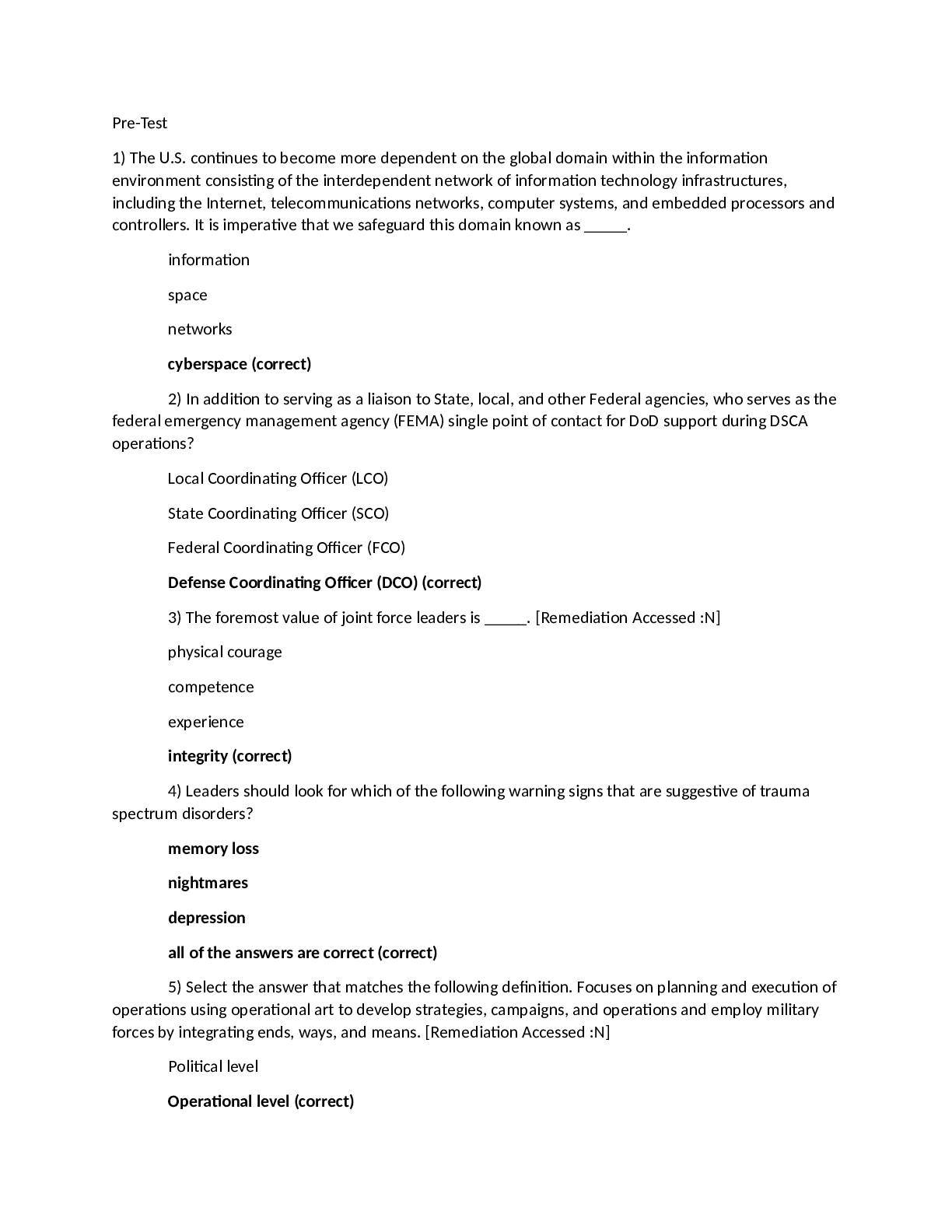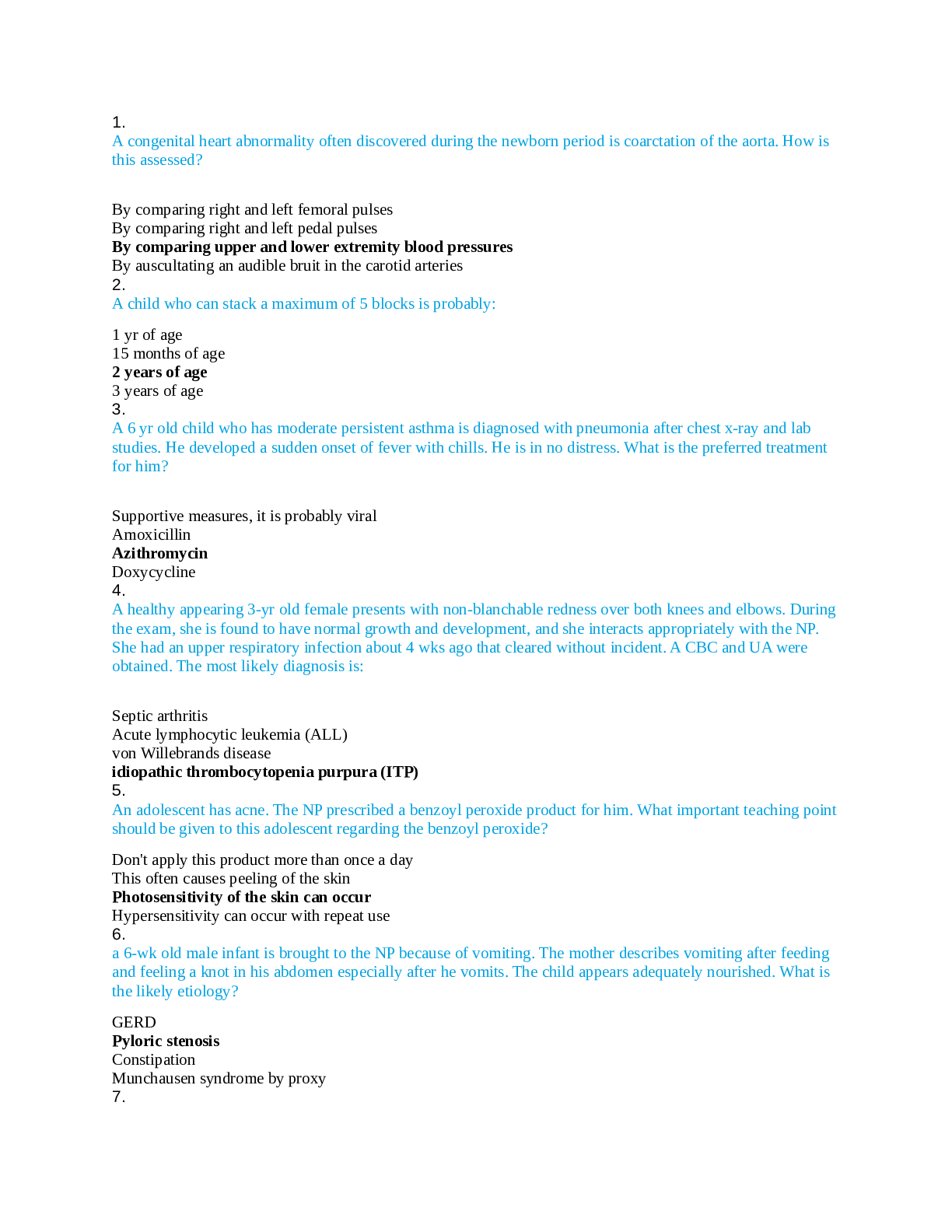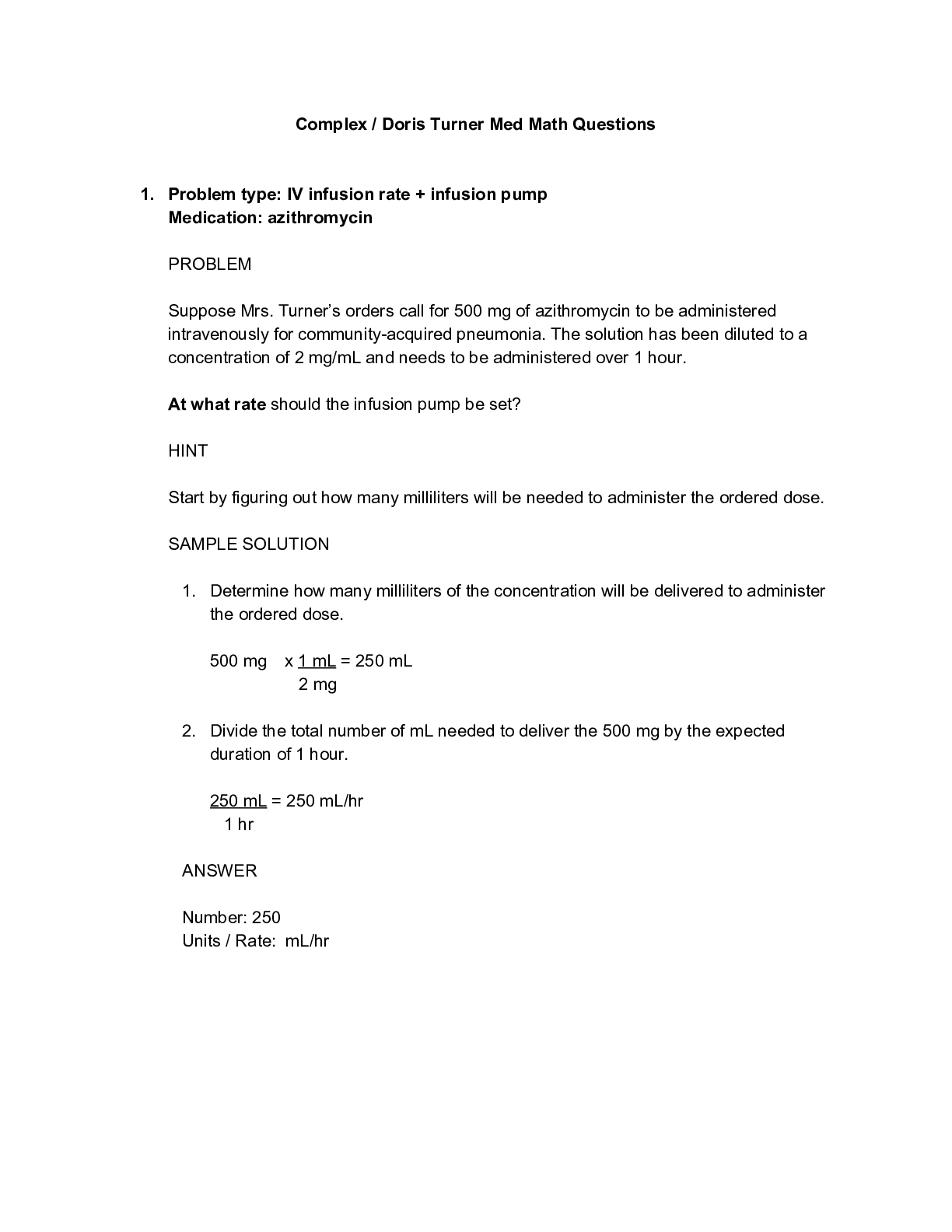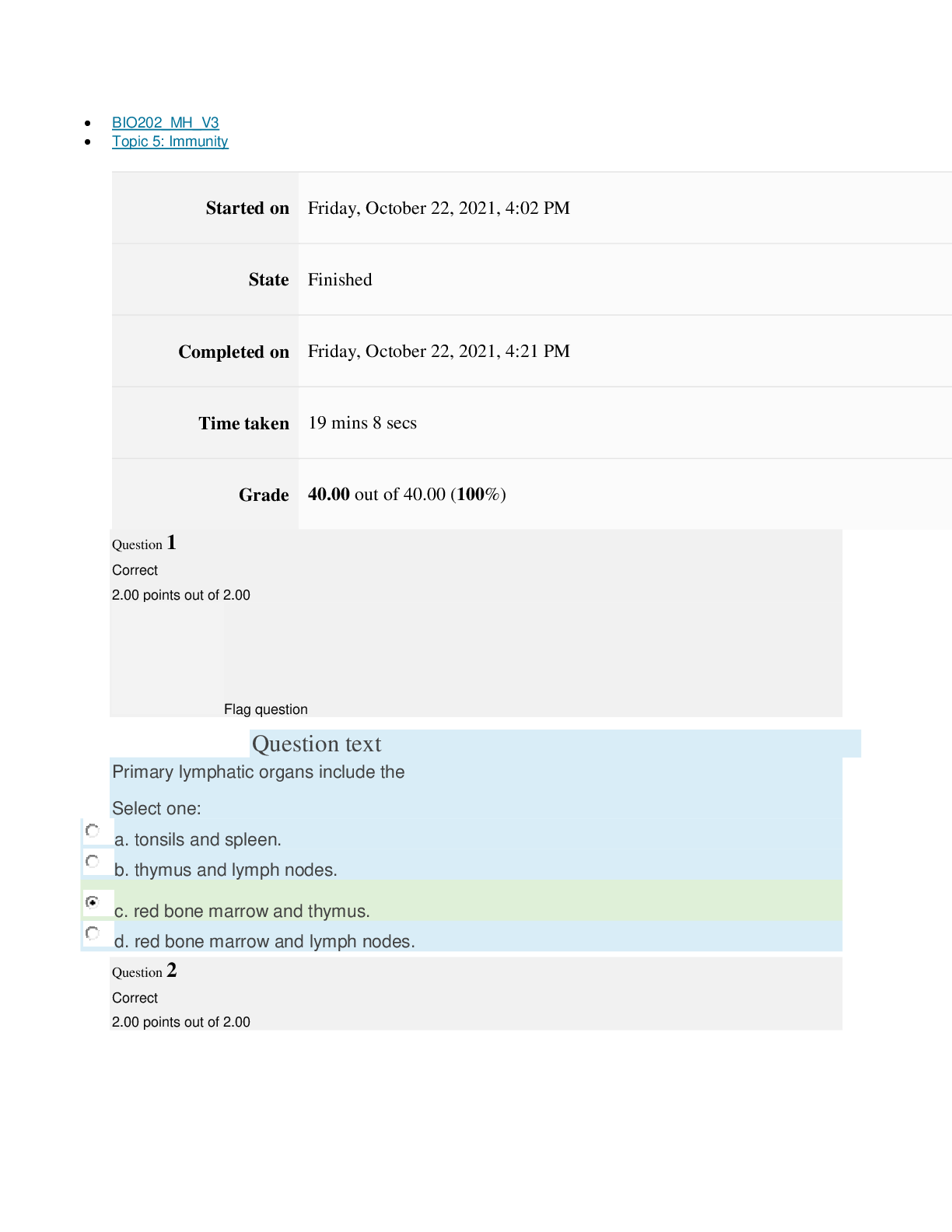Anatomy and Physiology - A&P 2 > QUESTIONS & ANSWERS > BIO202_MH_V3_Topic 9: Urinary System (GRADED A+) PERFECT REVISION TOOL (All)
BIO202_MH_V3_Topic 9: Urinary System (GRADED A+) PERFECT REVISION TOOL
Document Content and Description Below
BIO202_MH_V3 Topic 9: Urinary System Started on Friday, October 22, 2021, 6:52 PM State Finished Completed on Friday, October 22, 2021, 7:15 PM Time taken 23 mins 23 secs Grade 40.00 out... of 40.00 (100%) Question 1 Correct 2.00 points out of 2.00 Flag question Question text All of the following are located in the renal cortex, except Select one: a. collecting ducts. b. renal corpuscles. c. proximal convoluted tubules. d. distal convoluted tubules. e. afferent arteriole. Question 2 Correct 2.00 points out of 2.00 Flag question Question text Arrange the following in the sequence in which filtrate moves through them. (1) loop of Henle (2) Bowman's capsule (3) distal convoluted tubule (4) proximal convoluted tubule Select one: a. 1, 2, 3, 4 b. 4, 2, 1, 3 c. 2, 4, 3, 1 d. 2, 4, 1, 3 e. 3, 4, 1, 2 Question 3 Correct 2.00 points out of 2.00 Flag question Question text Filtration slits is the name given to the Select one: a. points where the afferent arterioles enter the renal corpuscle. b. openings between the endothelial cells of the glomerular capillaries. c. gaps between the podocyte processes in the visceral layer of Bowman's capsule. d. basement membrane of the glomerular endothelium. e. active transport channels. Question 4 Correct 2.00 points out of 2.00 Flag question Question text An obstruction in the afferent arteriole would reduce the flow of blood into the Select one: a. glomerulus. b. renal artery. c. macula densa. d. efferent arteriole. e. arcuate artery. Question 5 Correct 2.00 points out of 2.00 Flag question Question text Which of the following structures is a capillary? Select one: a. glomerulus b. loop of Henle c. collecting duct d. Bowman's capsule e. proximal convoluted tubule Question 6 Correct 2.00 points out of 2.00 Flag question Question text The structural and functional units of the kidney are called Select one: a. nephrons. b. renal papillae. c. renal pyramids. d. renal columns. e. renal tubes. Question 7 Correct 2.00 points out of 2.00 Flag question Question text The portion of the kidney that is composed of cone-shaped renal pyramids is called the Select one: a. cortex. b. medulla. c. pelvis. d. calyx. e. columns. Question 8 Correct 2.00 points out of 2.00 Flag question Question text Blood vessels, nerves, and the ureter enter and leave the kidney at the Select one: a. hilum. b. renal fascia. c. renal pelvis. d. renal capsule. e. renal pyramid. Question 9 Correct 2.00 points out of 2.00 Flag question Question text To calculate plasma clearance of any substance, it is necessary to know the Select one: a. quantity of urine produced per minute. b. concentration of the cleared substance in the urine. c. concentration of the cleared substance in the blood. d. blood volume. e. quantity of urine produced per minute, the concentration of the cleared substance in the urine, and the concentration of the cleared substance in the blood. Question 10 Correct 2.00 points out of 2.00 Flag question Question text Blood loss that occurs during surgery will stimulate cells in the Select one: a. efferent arteriole. b. wall of the right atrium. c. proprioceptors. d. juxtaglomerular apparatus. e. None of these choices is correct. Question 11 Correct 2.00 points out of 2.00 Flag question Question text Stretch receptors in the atria are responsible for the secretion of Select one: a. ADH. b. renin. c. aldosterone. d. atrial natriuretic hormone. e. angiotensin. Question 12 Correct 2.00 points out of 2.00 Flag question Question text As ADH production declines, Select one: a. glomerular filtration increases. b. potassium reabsorption increases. c. reabsorption of water increases. d. the urine volume increases. e. the blood volume increases. Question 13 Correct 2.00 points out of 2.00 Flag question Question text If the tubular maximum for a particular amino acid is 200 mg/100 ml and the concentration of that amino acid in the blood is 100 mg/100 ml, the amino acid Select one: a. will be actively secreted into the filtrate. b. will be completely reabsorbed by the tubule cells. c. will appear in the urine. d. will not appear in the urine. e. None of these choices is correct. Question 14 Correct 2.00 points out of 2.00 Flag question Question text In the myogenic mechanism of autoregulation, what is the response to an increase in blood pressure in the afferent arteriole? Select one: a. constriction of the glomerulus b. dilation of the afferent arteriole c. dilation of the efferent arteriole d. constriction of the afferent arteriole Question 15 Correct 2.00 points out of 2.00 Flag question Question text Removal of the posterior pituitary will immediately cause Select one: a. a decrease in urine volume. b. an increase in urine volume. c. no change in urine volume. Question 16 Correct 2.00 points out of 2.00 Flag question Question text Filtrate reabsorption, which occurs regardless of the concentration and volume of urine produced, is referred to as Select one: a. active. b. obligatory. c. facultative. d. countercurrent. e. nonessential. Question 17 Correct 2.00 points out of 2.00 Flag question Question text Which of the following is NOT an effect of aging on the kidneys? Select one: a. decrease in kidney size b. loss of nephrons c. decreased response to hormonal control of urine volume d. a marked decrease in the ability to maintain homeostasis Question 18 Correct 2.00 points out of 2.00 Flag question Question text Effects of aging on the kidneys include all of the following, except Select one: a. an increased ability to eliminate uric acid and creatine from the blood. b. a gradual decrease in the size of the kidneys. c. a gradual decrease in blood flow through the kidneys. d. a loss of general function. e. a decline in absorption and secretion. Question 19 Correct 2.00 points out of 2.00 Flag question Question text With aging, a loss of inhibitory action potentials to the sacral region of the spinal cord results in Select one: a. increased bladder capacity. b. voluntary micturition. c. continuous dribbling of urine. d. uncontrollable micturition. e. lack of control of internal sphincter. Question 20 Correct 2.00 points out of 2.00 Flag question Question text In order to regulate the pH of extracellular fluid, the kidneys are able to adjust the excretion of: Select one: a. hydrogen ions. b. calcium. c. sodium. d. magnesium. e. potassium. [Show More]
Last updated: 2 years ago
Preview 1 out of 11 pages
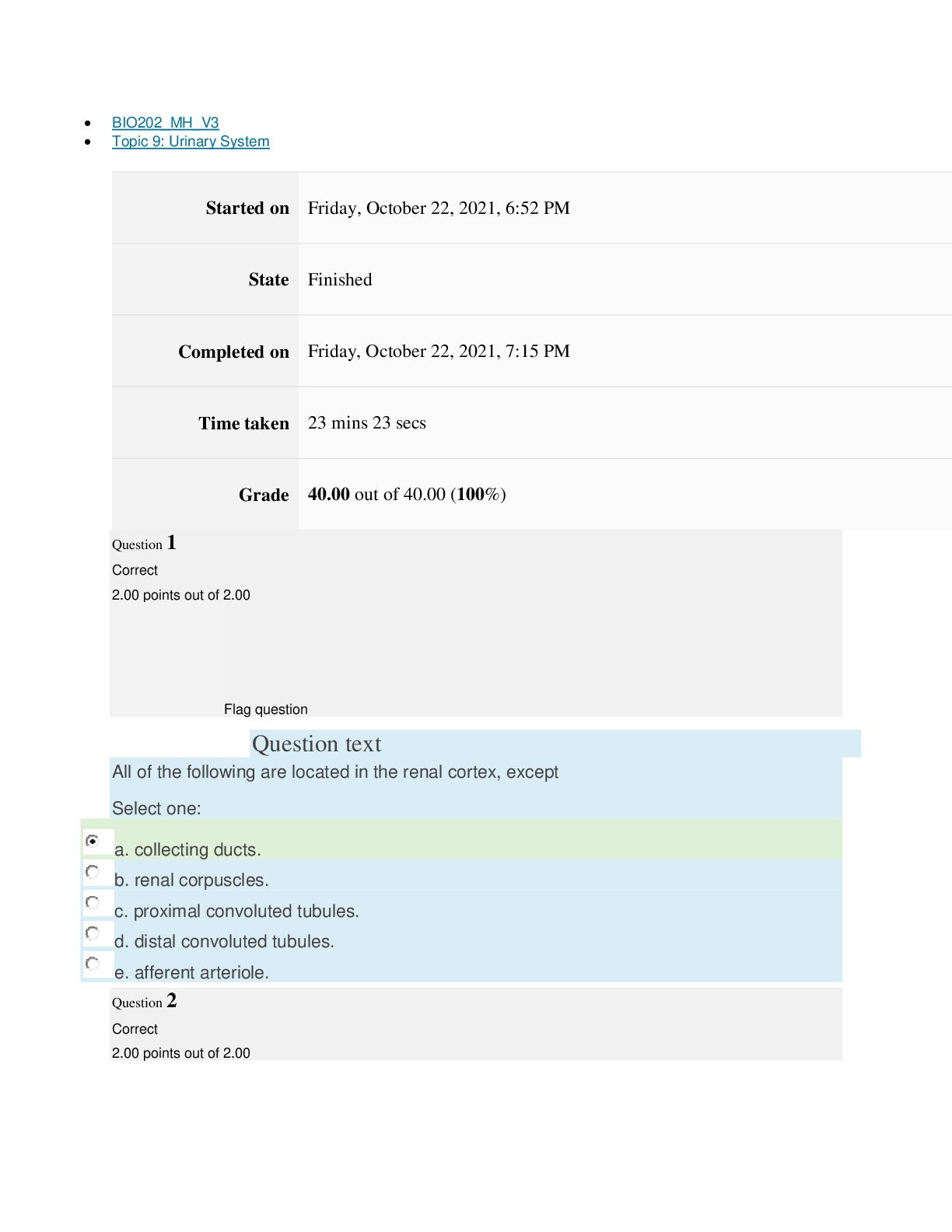
Buy this document to get the full access instantly
Instant Download Access after purchase
Buy NowInstant download
We Accept:

Reviews( 0 )
$7.00
Can't find what you want? Try our AI powered Search
Document information
Connected school, study & course
About the document
Uploaded On
Dec 04, 2022
Number of pages
11
Written in
Additional information
This document has been written for:
Uploaded
Dec 04, 2022
Downloads
0
Views
258



